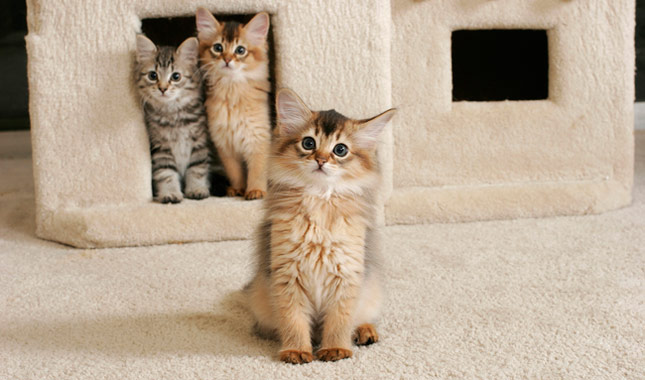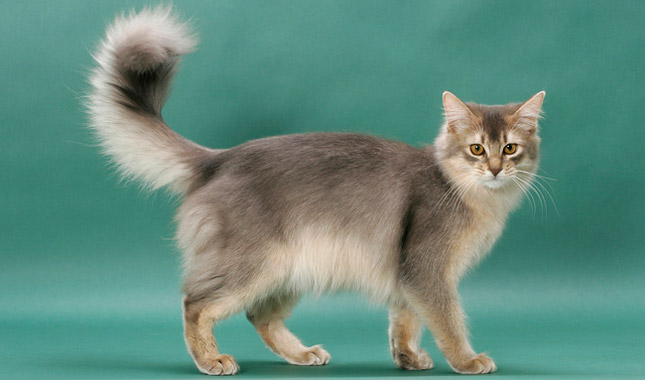Somali
Published on July 10, 2011
Breed Characteristics
Adaptability
Energy Level
Child Friendly
Social Needs
Shedding Level
Grooming
Health Issues
Stranger Friendly
Affectionate
Dog Friendly
Intelligence
If you love the confident air and athletic physique of the Abyssinian but prefer the glamour of a longhaired cat, take a look at the Aby’s sibling, the Somali, a foxy lady if ever there was one. Like the Abyssinian, the Somali bears a look of the wild and is characterized by large ears, a masked face, a full ruff, britches on the legs, a bushy tail and a ticked coat in ruddy, red, fawn and blue. The Somali’s mischievous nature is often likened to that of a monkey. Clever, curious, entertaining and highly active, this is not a cat for the person who lacks a sense of humor or any desire to interact with a highly intelligent, highly mobile cat capable of opening doors and squeezing into small spaces.
The Somali does best with a person who spends a lot of time at home and doesn’t mind being an only cat. If you are away from home during the day, though, it’s best to grit your teeth at the thought of double the mayhem and get him a Somali playmate to keep him company.
The Somali’s long coat is easy to manage if you comb it a couple of times a week to prevent or remove mats and tangles. Trim the nails and clean the ears as needed. Good dental hygiene is essential. The Somali is prone to plaque and tartar buildup, leading to periodontal disease, so regular brushing (with a pet toothpaste) and veterinary dental care is a must.
Other Quick Facts
- The semi-longhaired Somali’s coat is generally soft, but texture can vary depending on color because of the way pigment particles are shaped and distributed within the hair shaft. The coat can be ruddy, chocolate, cinnamon, blue, lilac or fawn, or a silver version of those colors: an ice-white coloration next to the skin with ticking up the hair shaft.
- The medium-size Somali has a long, lithe, muscular body supported by long, slim, muscular legs and oval feet. He often looks as if he is standing on his tip-toes. His head is a modified wedge shape with rounded curves. He has large ears, large almond-shaped eyes in gold, amber or green that are encircled by a ring of dark color and then one of a lighter color.
- The Somali’s bushy tail has given him the nickname “fox cat.”
The History of the Somali
The Somali is the longhaired variety of the Abyssinian, a cat whose origin is surrounded by many romantic tales. Despite his name, he’s not from Somalia (the next door neighbor to Ethiopia, formerly known as Abyssinia) but more likely the coast of the Indian Ocean and parts of Southeast Asia. He resembles a small African wildcat but is domestic through and through. Breeds that probably figured in his background include Siamese, Burmese and Russian Blues. The longhaired gene was introduced after World War II when breeders were trying to bring the breed back after the privations of the war.
It wasn’t until the 1960s that Somalis truly began to be developed as a breed. The Aby is highly popular, but the Somali is less well known.
Somali Temperament and Personality
Don’t get a Somali if what you’re looking for is a sweet, gentle lap cat or a living sculpture who requires little interaction. Like his sibling the Abyssinian, the Somali is curious, highly active and athletic, and loves to play. Constantly on the move, he spends his days climbing to high places, exploring every nook and cranny in your home, supervising whatever you’re doing, and bird-watching from the window or an outdoor enclosure.
To keep your smart-as-a-whip Somali entertained and out of trouble, provide him with puzzle toys that require him to think and move to release treats or kibble, use a clicker to teach him tricks, train him to run an agility course — really! — place a bird feeder in your window for his viewing pleasure, or teach him to walk on a leash and take him for a stroll.
This cat does best with a person of any age who spends a lot of time at home and will enjoy interacting with him, including an older child who will train and play with him. The Somali likes to be the center of attention and prefers to be an only cat so he can nab all the attention you have to give. His people-watching skills are excellent, and he is known for quickly training humans to do his bidding.
Always choose a kitten from a breeder who raises litters in the home and handles them from an early age. Meet at least one and ideally both of the parents to ensure that they have nice temperaments.
What You Need To Know About Somali Health
All cats have the potential to develop genetic health problems, just as all people have the potential to inherit a particular disease. Any breeder who claims that her breed has no health or genetic problems is either lying or is not knowledgeable about the breed. Run, don’t walk, from any breeder who does not offer a health guarantee on kittens, who tells you that the breed is 100 percent healthy and has no known problems, or who tells you that her kittens are isolated from the main part of the household for health reasons.
Some Somalis, like some Abyssinians, can develop a hereditary health issue called pyruvate kinase deficiency that can be a concern, especially if you aren’t cautious about who you buy from. Pyruvate kinase is a key regulatory enzyme in the metabolism of sugar. Cats deficient in PK typically have intermittent anemia. The deficiency can appear in Somalis as young as 6 months and as old as 12 years. The hereditary condition is caused by a recessive gene. A DNA test is available to determine whether a cat is normal, a carrier or affected by PK deficiency. Testing for PK deficiency and breeding away from it will eventually help to eliminate the disease from the breed.
Not every PK-deficient cat develops clinical signs, which vary but include lethargy, depression, lack of appetite, and pale gums. The best treatment for PK deficiency is unknown, but it’s still a good idea to have a Somali tested for it.
Other problems that may be seen in the breed include a disorder called renal amyloidosis, a neuromuscular condition called myasthenia gravis, and an eye disease called progressive retinal atrophy, which eventually leads to blindness. Ask the breeder if both of a kitten’s parents have been tested for genetic problems that affect the breed, and never buy from a breeder who does not offer a written health guarantee.
Remember that after you’ve taken a new kitten into your home, you have the power to protect him from one of the most common health problems: obesity. Keeping a Somali at an appropriate weight is one of the easiest ways to protect his overall health. Make the most of your preventive abilities to help ensure a healthier cat for life.
The Basics of Somali Grooming
The Somali has a soft, fine, dense, medium-length double coat. He should have a ruff around the neck and “breeches” on the thighs of the rear legs. Brush or comb the hair weekly to prevent or remove tangles or mats.
Somalis can be prone to periodontal disease, so brush their teeth frequently at home with a vet-approved pet toothpaste and schedule regular veterinary dental cleanings.
The rest is basic care. Trim the nails as needed, usually weekly. Check the ears every week for signs of redness or a bad odor that could indicate infection. Clean the ears only if they look dirty. Wipe them out with a cotton ball dampened with a gentle ear cleanser recommended by your veterinarian.
Choosing a Somali Breeder
You want your Somali to be happy and healthy so you can enjoy your time with him, so do your homework before you bring him home. For more information on the history, personality and looks of the Somali, or to find breeders, visit the websites of the Cat Fanciers Association, Cats Center Stage, the Fanciers Breeder Referral List, and The International Cat Association.
A reputable breeder will abide by a code of ethics that prohibits sales to pet stores and wholesalers and outlines the breeder’s responsibilities to their cats and to buyers. Choose a breeder who has performed the health certifications necessary to screen out genetic health problems to the extent that is possible, as well as one who raises kittens in the home. Kittens who are isolated can become fearful and skittish and may be difficult to socialize later in life.
Lots of reputable breeders have websites, so how can you tell who’s good and who’s not? Red flags include kittens always being available, multiple litters on the premises, having your choice of any kitten, and the ability to pay online with a credit card. Those things are convenient, but they are almost never associated with reputable breeders.
Whether you’re planning to get your feline friend from a breeder, a pet store, or another source, don’t forget that old adage “let the buyer beware”. Disreputable breeders and unhealthy catteries can be hard to distinguish from reliable operations. There’s no 100% guaranteed way to make sure you’ll never purchase a sick kitten, but researching the breed (so you know what to expect), checking out the facility (to identify unhealthy conditions or sick animals), and asking the right questions can reduce the chances of heading into a disastrous situation. And don’t forget to ask your veterinarian, who can often refer you to a reputable breeder, breed rescue organization, or other reliable source for healthy kittens. Put at least as much effort into researching your kitten as you would into choosing a new car or expensive appliance. It will save you money in the long run.
Be patient. Depending on what you are looking for, you may have to wait six months or more for the right kitten to be available. Many breeders won’t release kittens to new homes until they are between 12 and 16 weeks of age.
Before you buy a kitten, consider whether an adult Somali might be a better choice for your lifestyle. Kittens are loads of fun, but they’re also a lot of work and can be destructive until they reach a somewhat more sedate adulthood. With an adult, you know more about what you’re getting in terms of personality and health. If you are interested in acquiring an adult cat instead of a kitten, ask breeders about purchasing a retired show or breeding cat or if they know of an adult cat who needs a new home.
Make sure you have a good contract with the seller, shelter or rescue group that spells out responsibilities on both sides. In states with “pet lemon laws,” be sure you and the person you get the cat from both understand your rights and recourses.
Kitten or adult, take your Somali to your veterinarian soon after adoption. Your veterinarian will be able to spot problems, and will work with you to set up a preventive regimen that will help you avoid many health issues.
Adopting a Cat from Somali Rescue or a Shelter
A breeder is not your only option for acquiring a Somali. Adult Somalis may be available from rescue groups. It’s unlikely that you will find a Somali in a shelter, but it doesn’t hurt to look. Sometimes pedigreed cats end up at the shelter after losing their home to an owner’s death, divorce or change in economic situation. Check the listings on Petfinder, Adopt-a-Pet.com or the Fanciers Breeder Referral List, and ask breeders if they know of a Somali who is in need of a new home.
Here are some tips to help you find and adopt the right cat from a rescue group or shelter:
1. Use the Web
Sites like Petfinder.com can have you searching for a Somali in your area in no time flat. The site allows you to be very specific in your requests (a specific color, for example) or very general (all the Somalis available on Petfinder across the country). AnimalShelter can help you find animal rescue groups in your area. Also some local newspapers have “pets looking for homes” sections you can review.
Social media is another great way to find a cat. Post on your Facebook page that you are looking for a specific breed so that your entire community can be your eyes and ears.
2. Reach Out to Local Experts
Start talking with all the pet pros in your area about your desire for a Somali. That includes vets, cat walkers, and groomers. When someone has to make the tough decision to give up a cat, that person will often ask her own trusted network for recommendations.
3. Talk to Breed Rescue
Networking can help you find a cat that may be the perfect companion for your family. You can also search online for other Somali rescues in your area. Most people who love Somalis love all Somalis. That’s why breed clubs have rescue organizations devoted to taking care of homeless cats. The Somali Club’s rescue network can help you find a cat that may be the perfect companion for your family. You can also search online for other Somali rescues in your area.
4. Key Questions to Ask
You now know the things to discuss with a breeder, but there are also questions you should discuss with shelter or rescue group staff or volunteers before you bring home a cat. These include:
- What is his energy level?
- How is he around other animals?
- How does he respond to shelter workers, visitors, and children?
- What is his personality like?
- What is his age?
- Is he litter box-trained?
- Has he ever bitten or scratched anyone that they know of?
- Are there any known health issues?
Wherever you acquire your Somali, make sure you have a good contract with the seller, shelter or rescue group that spells out responsibilities on both sides. In states with “pet lemon laws,” be sure you and the person you get the cat from both understand your rights and recourses.
Kitten or adult, take your Somali to your veterinarian soon after adoption. Your veterinarian will be able to spot problems, and will work with you to set up a preventive regimen that will help you avoid many health issues.











